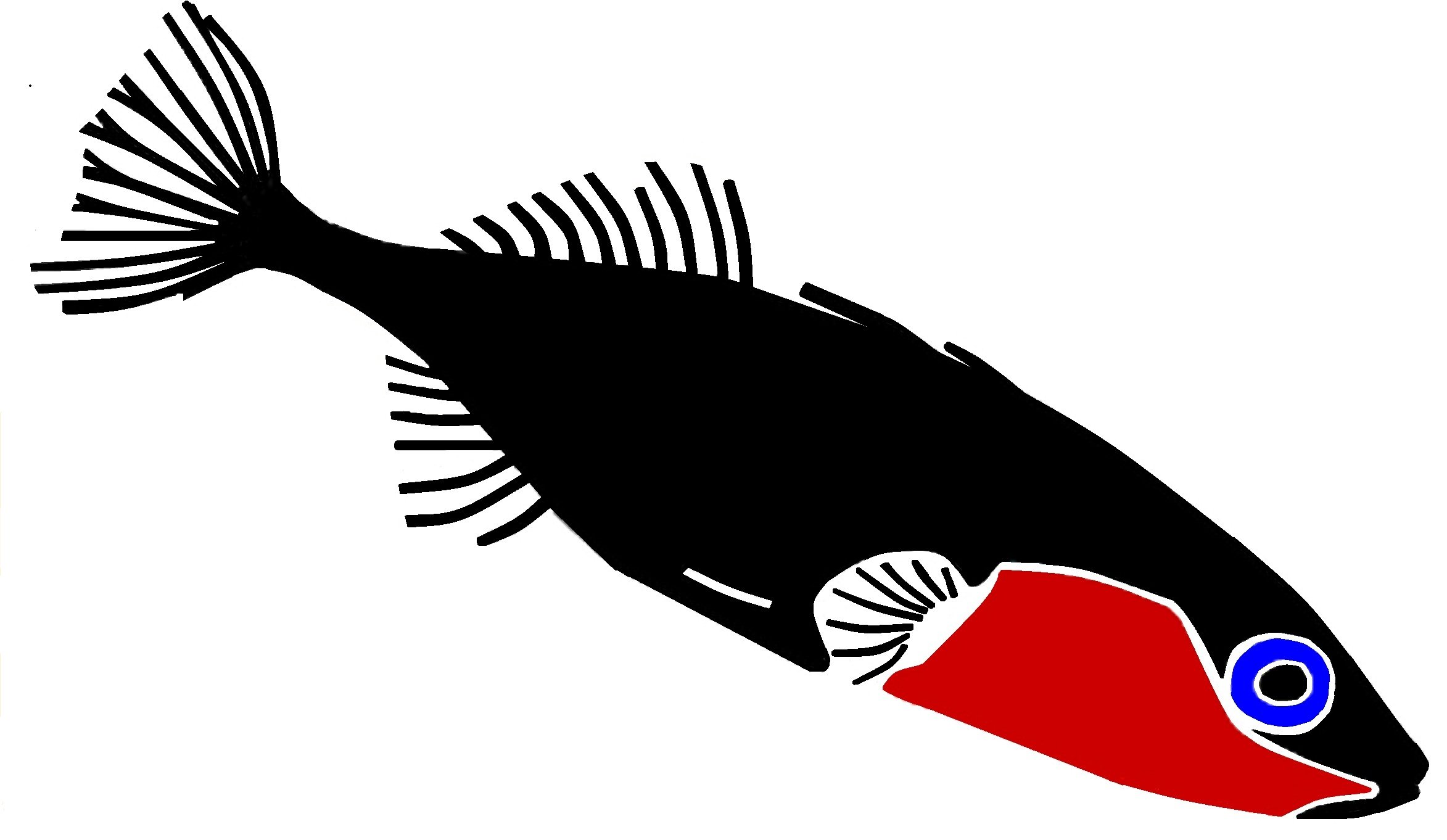Kids and the Kelvin
About
Kids and the 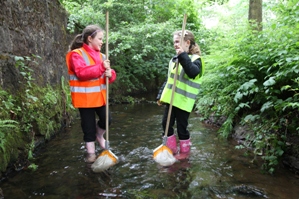 Kelvin 2011 has finished. 357 pupils from 14 schools in the Kelvin Valley LEADER area took part. We learnt how to look after fish in a hatchery and raised trout eggs in the classroom. We released the fish in our local burn. We revisited the river to watch electrofishing in action and see our local fish species up-close. We took kick samples from our burn and took the samples back to the classroom. We identified the many river invertebrates (wee beasties!) living in our river and learnt how invertebrates are linked to the health of the river ecosystem. We also learnt how to use microscopes. And we made caddis fly larvae out of pipe cleaners!
Kelvin 2011 has finished. 357 pupils from 14 schools in the Kelvin Valley LEADER area took part. We learnt how to look after fish in a hatchery and raised trout eggs in the classroom. We released the fish in our local burn. We revisited the river to watch electrofishing in action and see our local fish species up-close. We took kick samples from our burn and took the samples back to the classroom. We identified the many river invertebrates (wee beasties!) living in our river and learnt how invertebrates are linked to the health of the river ecosystem. We also learnt how to use microscopes. And we made caddis fly larvae out of pipe cleaners!
As a direct result of the project, pupils from Chapelgreen and Twechar Primary schools were the first people in over a hundred years to see salmon in the Queenzie Burn and the Board Burn! Other notable highlights were a fly-casting lesson from the Campsie Angling Association and finding a very big eel in the Ebroch burn!
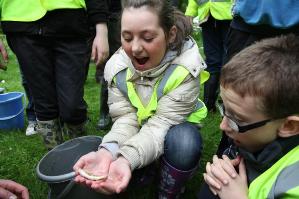
We hope that the project has helped make everyone a bit more aware of their local river. We also hope that everyone who took part understands why the health of their river is linked to the health of their community.
Project Info
PHASE 1:
Launch Day – A multi-media presentation at the Glasgow Science Centre (GSC)
on 1 February 2011. The children were given a talk describing the geography and history of the River Kelvin, the fish that live there, and their life histories and habitat requirements. Management of the fish and habitats were also described. A second presentation described the classroom hatchery and its maintenance and introduced the children to the brown trout. The pupils then had the chance to explore the GSC Science Mall.
Maintaining a “Classroom Hatchery” (February and March 2011).
A simple “hatchery” was installed in each school by the Clyde River Foundation (CRF). Brown trout eggs were placed in the hatchery and the children encouraged to follow the development of the young fish for two months, before they were released into their local burn. While the hatchery was operational, CRF scientists visited each class weekly to interact with the children and to support the teacher.
PHASE 2:
Meet Your River Day – Pupils were taken to their local burn or river and were introduced to the methods that CRF scientists use to measure the health of the watercourses (including an electric fishing demonstration). The children were given a chance to try some of the techniques and to take samples back to their school for further study. The pupils determined the health of their local watercourse, and compared it with others throughout the Kelvin Valley LEADER area. They completed several practical tasks to demonstrate their understanding of the learning outcomes.
Kids and the Kelvin combined learning and teaching activities previously delivered elsewhere by the Clyde River Foundation. In addition, there was a development of teaching materials specific to the Kelvin Valley LEADER area.
Kids and the Kelvin used the life-cycle of the brown/sea trout to engage almost 400 children with their local environment. Kids and the Kelvin was a self-contained environmental project which teachers could use to enhance all learning outcomes within the Curriculum for Excellence. Pupils developed skills in science and positive attitudes towards social and environmental responsibility.
Logo Competition
At the start of 2011, the Clyde River Foundation decided to design a logo for the Kids and the Kelvin project, but our own efforts were so woeful that we thought it best to leave it to the creative powers of the many budding artists in schools around the Kelvin river catchment.
We announced a logo design competition and sought entries from participating schools. We also promised that selected designs would be showcased on this page and one talented entrant will have their design used as the logo for the project.
We have already received some great entries so we thought it would be nice to show them off here. If any schools would like to submit some last minute logo entries it’s not too late. We’ve extended the deadline to Friday 15th April. But that really is the deadline…!
Logo Competition Winner
A pupil from Lennoxtown Primary sketched the winning entry with a striking design of a young trout and some excellent river-style lettering.
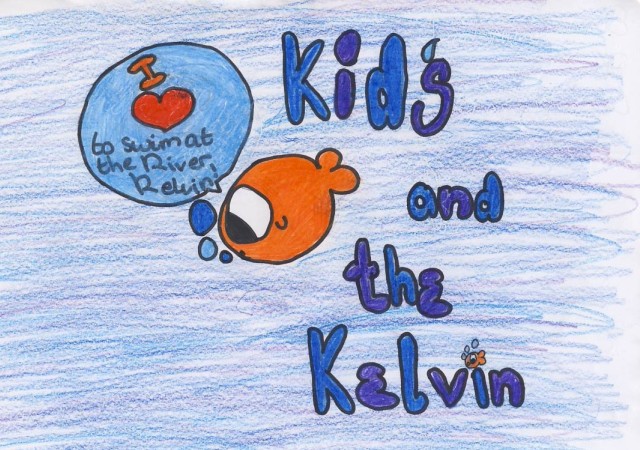
Congratulations!!!
The logo for the project website will be based on the design, so keep an eye on the website over the summer.
There were lots of tremendous entries to the competition and we’d like to thank everyone who took part.
Associated Primaries
14 schools from the River Kelvin catchment area participated in the project:
- Balmalloch Primary
- Banton Primary
- Chapelgreen Primary
- Harestanes Primary
- Hillhead Primary
- Holy Cross Primary
- Kilsyth Primary
- Lairdsland Primary
- Lennoxtown Primary
- Oxgang Primary
- St Flannans Primary
- St Machans Primary
- St Patricks Primary
- Twechar Primary
Latest School Updates
Harestanes pupils meet their river….
Harestanes primary school pupils were transformed into young scientists for the day, as they took kick samples from the Luggie Water and observed electrofishing by the Clyde River Foundation. Here are some pictures from the day. We’d love it if you could supply captions for the images…. get in touch via the website to send in your captions.
Holycross find trout (and knotweed…) along the Garrel burn
Not only did pupils from Holycross primary school gather an impressive sample of invertebrates from their local river, they also found a non-native plant on the banks of the Garrel. After watching the Clyde River Foundation’s Davie and Justyna electrofish in the burn – allowing them to see up close some healthy-sized trout – they walked along the river on the hunt for a less welcome part of the ecosystem. As part of the project, pupils were challenged to find any of the four major ‘Invasive Non-native’ plant species that can now be found in Scotland (Japanese Knotweed, Himalayan Balsam, Giant Hogweed, Skunk Cabbage). And unfortunately they did just that, tracking down a large stand of Japanese Knotweed just opposite the football park. Well done for honing those identification skills….!
St Patricks find plenty of life in the burn
Freshwater slaters, leeches and mayfly were just a few of the creatures found by St Patrick’s primary pupils after they donned the wellies and took kick-samples to identify back in the classroom.
Oxgang looks at the Luggie
The Luggie Water flows just 50 yards from the school gates of Oxgang primary and pupils had the chance to explore their very local river as part of the Kids and the Kelvin Meet Your River day. Pupils from P4 put some serious welly into researching the health of the Luggie by taking samples from the riverbed and watching Clyde River Foundation scientists electrofish beneath the bridge beside Waterside roundabout.
St Flannan’s find plenty of fish
St Flannan’s pupils found plenty of fish in the Luggie Water, including a good-sized salmon parr and a beautiful three-spined stickleback. The stickleback (Willie’s favourite fish!) had a bright red belly, signalling the first steps in its courtship behaviour.
Kilsyth pupils find eel in the Ebroch
It might not look very healthy, but Kilsyth pupils discovered that the Ebroch burn is home to a wide range of fish and invertebrate life during their Meet the River day. As well as watching a number of good-sized trout being scooped out of the Ebroch burn, they saw a very impressive eel which had been lurking in the muddy banking….What a find!
Salmon star in the Luggie
A TV film crew spent the morning with Hillhead primary school recently as part of a BBC documentary series about Scottish salmon. During Hillhead’s Meet Your River day, scientists from the Clyde River Foundation waded into the Luggie Water to show the pupils electrofishing in action. Due to industrial pollution, salmon disappeared from the Luggie for many years, but since the mid-1980s they have started to return – a story of urban freshwater regeneration that the attendant film crew was hoping to catch on camera. And Hillhead were not disappointed – pupils watched from the bridge as a healthy-looking salmon parr was scooped from the river. The documentary will likely not be shown until early 2012!
Banton pupils put river beasties under the microscope
The pupils of Banton primary school found a wide range of inverterbrate species during their Meet Your River day, signalling that their burn is in pretty good health. After kick sampling in the Banton burn just down the road from the school, pupils got a closer look at the tiny creatures including mayflies, worms and some fascinating cased caddis fly larvae.
Thank you
A message from the Clyde River Foundation team: We’d like to thank everyone for taking part in the project. It has been an exciting few months and we hope everyone enjoyed it as much as we did: from raising the trout eggs in the classroom to exploring the river food web and finding out and identifying what invertebrates (wee ‘river beasties’!) the fish feed on. We hope you have a great summer! Keep an eye on the website.
Campsie anglers show St Machans how to fish
St Machan’s primary school were paid a special visit by representatives from the Campsie Angling Association in May. During the Meet Your River stage of the project, Danny Connor and Michael Cassidy gave pupils a demonstration of fly-casting, a first-hand insight into why it might be useful to know about the riverflies that inhabit the river. Thanks go to the Campsie Angling Association for their involvement and support of the project. After the electro-fishing, fly-casting, and kick-sampling, the pupils took invertebrate samples from the river back to the classroom for closer inspection. Have a look at some of the photos from the day.
Feedback
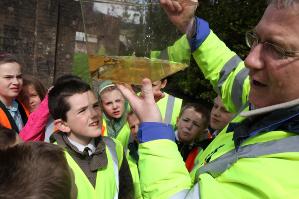
“My favourite thing was the electrofishing, kick sampling, identifying the fish and releasing the trout because I got to see everything in the burn” (Pupil from Chapelgreen Primary).
“I liked when we did the kick sampling because we got wet and saw loads of cool beasties” (Pupil from Harestanes Primary).
“I liked releasing the fish best because I felt really happy that we were improving the river by letting the fish go and we were doing good for the environment and I am so glad” (Pupil from Holycross Primary).
“I liked identifying the fish we caught and going down to the river and watching Lesley and David catch the fish with the electric equipment and I also liked kicksampling. I loved making the mayfly that was my favourite. my favourite was identifying the invertebrates because it was cool and a lot of thing I saw I didn’t know were alive” (Pupil from St Flannan’s Primary).
“What I liked best was catching the fish because of that big electric machine and the big fishes we seen, especially since we were the first people to see a salmon in the Board Burn” (Pupil from Twechar Primary).
“Child-centred project. Pupils took full responsibility for looking after the fish eggs” (Teacher, St Patricks Primary).
“The people working with the project were approachable and knowledgeable. They helped to make it a deeper learning experience for the children. Thanks” (Teacher, Chapelgreen Primary).
“I liked looking after the fish in school because we have never done anything like this before” (Pupil from Twechar Primary).
“I really enjoyed the field day activities. Both indoor and outdoor experiments provided excellent opportunities for the children to engage in active learning and to take responsibility for their learning” (Teacher, Oxgang Primary).
“I like looking in the microscopes because you can see what it really looks like and how it moves and see if they have scales or not” (Pupil from St Flannans Primary).
“The entire project was great. The children enjoyed every aspect of it and learned a lot” (Teacher, Kilsyth Primary).
Project Supporters
Kids and the Kelvin was delivered by the Clyde River Foundation, a registered charity which researches the ecology of the Clyde and its tributaries and promotes environmental education throughout the catchment.
We were grateful to the River Kelvin Angling Association, the Campsie Angling Association and the Glasgow Science Centre for their partnership and support of this project.
Kids and the Kelvin was funded by the Kelvin Valley LEADER programme and the project partners.
The Kelvin Valley LEADER programme was funded by the European Commission and is part of the Scotland Rural Development Programme 2007-2013, aimed at promoting economic and community development within rural areas.
